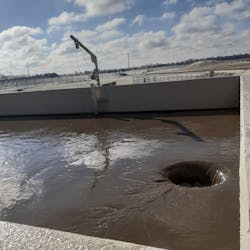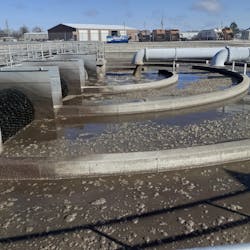Wastewater Mixer Retrofit Saves Energy & Installation Costs
At Valley Center Wastewater Treatment Plant, and at an increasing number of facilities across Kansas, upfront equipment costs, even when expensive, are showing strong returns for utilities. Savings in long-term maintenance are important, but in the shorter term, energy savings are fundamental.
“Total cost of ownership is what we at the plant and our city council are interested in,” said Wade Gaylord, Valley Center’s Utility Manager. “There’s always a cheap, short-term solution, but it is our duty to act in the best interests of the city and our residents to spend our budget as wisely as we can, which to me it just plain common sense.”
After being laid off from the aerospace industry during the pandemic, Wade sought employment in the wastewater sector, where he could put his university degrees in chemistry and geology to good use.
“I grew up here and later used to drive past the plant on South Sheridan and wonder what was going on in there,” he said. “After aerospace, I was prepared to travel to wherever a good career opportunity became available in the wastewater industry. But as it turned out, there just happened to be a vacancy for an operator, right here in Valley Center.”
Valley Center WWTP
Situated about 12 miles north of Wichita, the 0.5 million gallon per day (mgd) wastewater treatment plant (built in 1979) serves 2,700 homes. It includes an extended aeration treatment plant, plus ultraviolet disinfection treatment. Solids removal prior to discharge into the Little Arkansas River typically ranges from an impressive 97.5%-99%.
The recent failure of a mixer at Valley Center demonstrated the firm commitment that now prevails when the true cost of ownership is mapped out, only top quality, long-lasting equipment represents the best value for money.
Wade spoke with multiple equipment representatives, including Fluid Equipment of Wichita, who had been evaluating and repairing wastewater systems for more than 50 years. After listening to how Valley Center approached its purchasing, Jeff Ubben at Fluid Equipment recommended a Landia submersible mixer from its portfolio that sat at the top of their price bracket, but one that is set to last for 20 to 25 years.
“I immediately liked the Landia design”, added Wade, "Especially the sealing system, which protects the most important part of the mixer. We have great cohesion in our team here at Valley Center, including our Infrastructure Manager, Ron Ekstrom, who has worked here for over 20 years. When we thoroughly weighed out all the pros and cons, we saw that Landia was the most expensive purchase.
"However, when I presented the total cost of ownership to the city, they could see that it made by far the most sense. Our administration definitely looks for longevity, as well as best efficiency, and in 10 years’ time or less, I don’t want an operator to have to deal with the same problems that I’ve had.”
“With a Landia mixer, Valley Center can see that they won’t have the annoying maintenance issues that lesser designed mixers will create," he said, "And as well as lasting much longer, the mixer we recommended will also do a better job, even though it uses much less energy.”
With backward sweeping propellers, the design of the mixer ensures that rags cannot cling on and damage the seals. The protective grease hub in the propeller guards the seals, and is hard to wash away. It acts as an important first line of defense against all types of debris. The seal system also eliminates immediate and expensive seal fail conditions.
Ubben said Landia can very often reuse an existing mixer guiderail, so installation can proceed without requiring emptying of the tank.
Despite appearing to initially be at the high end of the price list, a retrofit of the equipment did not require much additional cost compared to installing new.
“We knew that the old 7.5 HP mixer was working and mixing – to some extent – but when the Landia mixer was installed, we turned it on and hadn’t seen the basin ever mixed like that before," Wade said. "The volume that the Landia mixer put through, mixing the basin from the bottom up, was pleasantly surprising; changing the dynamics for a much better process all round. All of this, too, with just a 4.9 HP motor."
Wade also said the amp draw was lower than other mixers he had reviewed, which mean that running two hours on and two hours off saved around $58 per week or $3,000 per year.
About the Author
Chris French
Chris French is a freelance writer on water, environment and renewable energy issues. French can be reached at [email protected].


